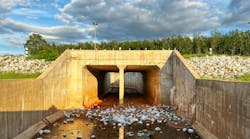Strategy to Reduce District’s Sewer Overflows Includes Green Infrastructure
(PHILADELPHIA – May 20, 2015) – The U.S. Environmental Protection Agency, the District of Columbia (District) and DC Water today announced an agreement to modify a 2005 federal consent decree (CD) allowing DC Water to incorporate green infrastructure in its long-term strategy for curtailing combined sewer overflows (CSOs).
The modification, filed yesterday in Federal District Court in Washington, D.C., gives DC Water the go-ahead to pursue an integrated green/gray infrastructure approach to address water quality issues in the Rock Creek and Potomac watersheds resulting from combined sewer overflows. This integrated approach utilizes green infrastructure in a targeted and sound engineering manner to reduce combined sewer overflows. Green infrastructure uses vegetation, soils, and natural processes that mimic nature, to soak up and store rainwater water where it falls to control wet weather pollution and create healthier urban environments.
“This modification represents significant efforts by all the parties to make green infrastructure an integral part of the solution to curtailing sewer overflows and protecting urban waters,” said EPA Regional Administrator Shawn M. Garvin. “We expect that the green infrastructure components of this modification will provide a model of sustainability for others to follow.”
“This innovative plan will significantly reduce sewer overflows into our rivers and capture rainwater in the area’s ecologically important watersheds,” said Assistant Attorney General John C. Cruden for the Justice Department’s Environment and Natural Resources Division. “This plan puts Washington, D.C. among America’s green city innovators, and it reflects the Justice Department’s and EPA’s commitment to work with cities to safeguard public health, adapt to climate change, and improve aging sewer infrastructure using smart and environmentally sound solutions.”
The green infrastructure projects in Rock Creek and Potomac watersheds are slated to begin in 2015 and 2016 respectively, providing more immediate pollution reductions, enhancements to community livability, and green jobs opportunities.
Specifically the CD modification includes:
- Using green infrastructure to retain the first 1.2 inches of rainwater on 365 acres in the Rock Creek area, and 133 acres in the Potomac watershed.
- Potentially eliminating the Rock Creek storage tunnel and significantly decreasing the size of the Potomac tunnel depending upon the success demonstrated by green infrastructure.
- The District providing the public space necessary for DC Water to construct the proposed green infrastructure projects, and making changes to District regulations, codes, standards, guidelines and policies needed for implementation.
- Requiring the District and DC Water to work together to coordinate capital projects and expenditures for implementing green infrastructure, enabling the efficient use of resources and minimizing costs to rate-payers and taxpayers.
As part of the agreement, DC Water will have an additional five years to complete implementation in the Potomac and Rock Creek watersheds beyond those provided for in the original 2005 consent decree, which established a compliance schedule to construct tunnels in the Anacostia, Potomac and Rock Creek watersheds. The schedule for completing the Anacostia tunnel remains unchanged.
Under this consent decree, DC Water will continue moving forward under this consent decree on the construction of the overall CSO control project which is known as the Clean Rivers Program. This program involves completion of, besides the components described above, control structures and tunnels for the Anacostia watershed, which contributes more than 65 percent of the sewage discharged to District waters annually. Major portions of this tunnel system are scheduled for completed and in operation in 2018. When the Anacostia tunnel complex is fully completed in 2025, it will nearly eliminate combined sewer overflows to the Anacostia in an average rainfall year.
In November 2011, DC Water proposed to EPA to incorporate green infrastructure into its overflow control strategies for the Potomac and Rock Creek watersheds. As part of the request, DC Water submitted analysis demonstrating that modified CSO controls in the Potomac and green infrastructure in Rock Creek could provide equivalent pollution reductions to those in the original plan and were economically feasible.
In early 2014, after conducting a public participation process, DC Water filed a request to EPA to modify the plan for CSO controls and deadlines set forth in the 2005 CD.
During the CD modification discussions, DC Water has continued to move forward in a timely fashion to enhance its nutrient reduction treatment systems at the Blue Plains Advanced Wastewater Treatment Plant. This is an important element of the Bay watershed restoration effort because the Blue Plains facility is the largest point source of nutrient pollution in the Chesapeake Bay drainage area. The proposed CD modification is subject to a 30-day public comment period once it is published for public notice in the Federal Register, and must be approved by the Court. The proposed CD modification will be available at: http://www.justice.gov/enrd/consent-decrees.Source: US EPA



